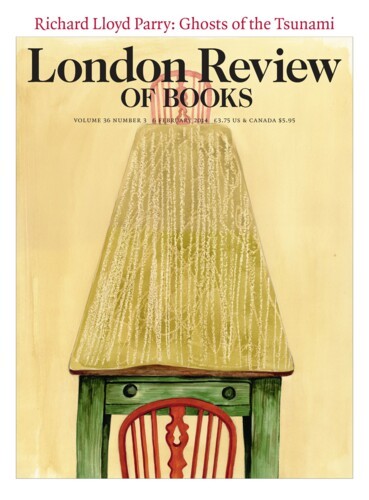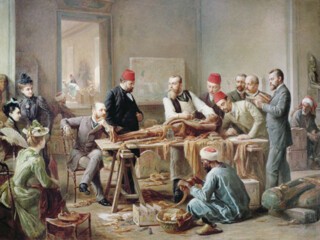In 1889, Rudyard Kipling, 23 years old, recently arrived in London and looking to ingratiate himself with England’s most popular novelist, wrote to Rider Haggard with the outline of a story he’d recently heard, a ‘thing picked up the other day across some drinks’:
There was first one Englishman and one mummy. They met in Egypt and the live man bought the dead, for it was a fine dead. Then the dead was unrolled and in the last layers of the cloth that malignant Egyptian had tucked away a communication service of the most awful kind to the address of any man who disturbed him. He should die horribly in the open as a beast dies at the hand of a beast and there should not be enough of him to put into a matchbox, much less a mummy case. Whereat they laughed and of course later the Englishman went to your country and became ‘fey’ insomuch that he was weak enough to fire a shot gun into an elephant’s trunk. Then he was dealt with after the manner of elephants till he was blackcurrant jam
... Were the mummy not in it I could and would take the thing and play with it. But there is a King of Egypt already and so I bring the body to his feet.
The Englishman he was talking about, cursed and pulped, was Lieutenant Walter Herbert Ingram, who had fought in South Africa in the Anglo-Zulu War and travelled up the Nile to Khartoum in the hope of helping General Gordon’s forces. In Luxor, he bought a sarcophagus from the British consul for £50, ‘as a kind of souvenir of his adventures in Egypt and the Soudan’, according to the Strand Magazine, and shipped it to England. The mummy’s gilded mask was donated to the British Museum; the coffin went to Lady Susan Meux for her private museum of Egyptian artefacts at Theobalds Park in Hertfordshire. She died in 1911, leaving her collection to the British Museum, but they didn’t want it: it was a condition of her bequest that it be kept together rather than absorbed into the general collection, and they weren’t having that, so the coffin was sold to William Randolph Hearst for £72. Ingram by this time was long dead. On a hunting trip in Somaliland with Lady Meux’s husband in 1888, he was, as Kipling relayed to Haggard, gored and trampled to death by an elephant he’d wounded but failed to kill when he shot it with too small a gun.
Ingram is one of three men – the others are the amateur Egyptologist Thomas Douglas Murray (1841-1911) and the fifth Earl of Carnarvon, who died within weeks of opening the tomb of Tutankhamun in February 1923 – whose stories Roger Luckhurst reconstructs in his alluring book, which shows that the mummy’s curse is one of those traditions (like celebrating Christmas or wearing clan tartans) whose origins are supposedly lost in the mists of time but were in fact invented by the Victorians. ‘For, as weary academic Egyptologists often explain,’ Luckhurst says, ‘Ancient Egyptian culture actually had very little concept of the curse.’ The real mystery that he has set out to solve has nothing to do with why so many people died horrible deaths after plundering the tombs of the pharaohs. For a start, it’s not clear that so many did: Douglas Murray only lost an arm, though the ‘Unlucky Mummy’ supposedly responsible for his misfortune was also rumoured to have been on board the Titanic when it sank. In fact it was sitting quietly in the British Museum, where you can still go and see it – object no. 22542 – if you dare. Attempts to rationalise the curse of Tutankhamun by speculating about long dormant viruses being released, or floating the possibility that Aleister Crowley murdered the tomb raiders, are misplaced.* ‘What remains so puzzling,’ Luckhurst says, ‘is the wholesale transformation during the course of the 19th century of feelings of awe, sublimity and wonder at the surviving traces of Ancient Egyptian culture to a sense of threat and menace.’ The story of the mummy’s curse, unsurprisingly, is far more revealing of attitudes and anxieties prevalent in 19th-century Britain than of anything in Ancient Egypt.
‘The first wave of Egyptomania,’ Luckhurst writes, ‘is commonly held to have hit England in the wake of the French surrender of Egypt in 1801.’ A rash of mock Egyptian architecture and interior design erupted across the country. ‘Everything must now be Egyptian,’ Robert Southey grumbled. ‘The ladies wear crocodile ornaments, and you sit upon a sphinx in a room hung around with mummies, and with the long black lean-armed long-nosed hieroglyphical men, who are enough to make the children afraid to go to bed.’ But nobody seems to have been especially afraid of the mummies, and fear wasn’t one of the thrills people went looking for during what Luckhurst calls the ‘brief craze for mummy unwrappings in the 1830s’.
One of the leading lights of these necrophiliac striptease shows was Thomas Pettigrew, a founding member of the Royal College of Surgeons and of the British Archaeological Association, who ‘probably unwrapped over forty mummies in his career’. He performed his first unrolling – of a mummy he’d bought at Sotheby’s for £23 – at Charing Cross Hospital in April 1833, as the finale of a lecture on embalming. Three months and two more unwrappings later, he was invited to repeat the feat at the Royal Institution, where he and his assistant ‘unrolled at least two hundred yards of bandages before the bituminous state of the rags made them inseparable from the body
Something must have happened, then, between Pettigrew’s fervent experiments of the 1830s and Ingram’s East African adventures of the 1880s to conjure up the mummy’s curse and bring it down on the heads of interfering Englishmen. The pivotal event, Luckhurst argues, was the opening of the Suez Canal in 1869, which slashed 4500 miles from the journey between Britain and India but left control of the new trade route out of British hands: Egypt had become the crux of an empire it was not yet part of. Britain acquired a controlling stake in the canal company in 1875 and seven years later put boots on the ground. The occupation was a short-term measure – to help the Khedive, who was compliant with Anglo-French interests, suppress the unco-operative Urabi rebellion – which lasted until 1956. ‘After the uprising and the 1882 occupation, coinciding with an explosion of new popular magazines and journals in England, Egypt became a premier location for the Imperial Gothic,’ Luckhurst writes. ‘The form refigured the structural violence of the colonial encounter in tales of insidious natives, long-buried curses, haunted museums and mysterious, vengeful objects.’
Soon curses were everywhere in fiction. In Guy Boothby’s Pharos the Egyptian, a ‘menacing Arab’ with ‘potent mesmeric powers’ lays a curse on the narrator that results in everyone else in London being wiped out by plague. In Richard Marsh’s The Beetle, which went through 15 editions between 1899 and the First World War, a vengeful giant beetle kills and kidnaps its way across the city before being wiped out in a train crash north of King’s Cross. In Bram Stoker’s The Jewel of Seven Stars (1903), an ancient and powerful evil comes to England in a coffin and struggles for possession of a young woman’s soul against a heroic brotherhood, in Luckhurst’s words, ‘of good Christian men’. But none of this fictional skulduggery can quite compare with a story Luckhurst tells about Ernest Wallis Budge, the real-life Keeper of Egyptian and Assyrian Antiquities at the British Museum, who in 1886 gathered eight hundred skulls from mummy pits in Aswan and got round the ban on the export of ancient artefacts by reclassifying them as ‘bone manure’.
Rider Haggard – who had an ‘obsession with the mummified dead’ – used some of the proceeds from She (1887) to fund a trip to Egypt. ‘Poor kings!’ he wrote in his autobiography, describing the royal mummies in the Cairo Museum, ‘who dreamed not of the glass cases
Send Letters To:
The Editor
London Review of Books,
28 Little Russell Street
London, WC1A 2HN
letters@lrb.co.uk
Please include name, address, and a telephone number.


